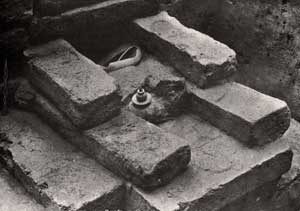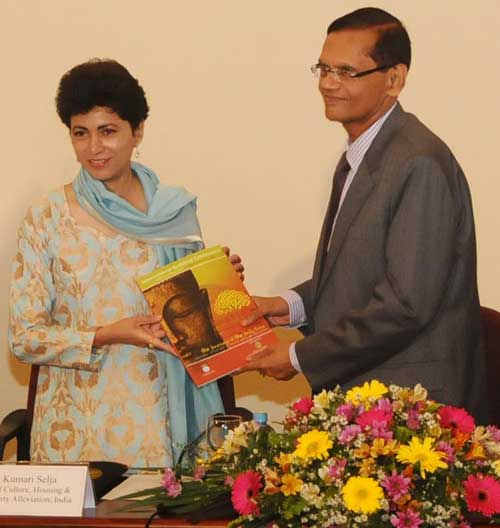The exposition of the sacred Kapilavastu Relics in Sri Lanka

‘Shraddha’ or devotion is the first door that reveals the marvels in the path to ultimate wisdom. Unwavering faith in a devotee can land him/ her on the shores of nibbhana, where the former plays a vital role in combining the more sophisticated essentials such as courage, wisdom and self-awareness. Ever since Buddhism emerged as an established philosophy and religion, pilgrims were not scarce and pilgrimages were not rare.
As the Mahaparinibbana sutta describes, for the devotees, the stupas that enshrine the relics of the Buddha and the Sangha are no mere symbols; in fact, they were built in order to remind them that the supra-human status attained by them could be emulated by anyone so long as his/her efforts are in the right direction (Samma Vayama). Even today, they are the monuments of veneration that speak to the emotional side of the devotee, who in his mind paints a face for a venerable human being, he had never seen. On the other hand, they repeat the ultimate truth of ‘anichcha,’ in which nothing but transience in life is intransient.
Ties between the neighbours
 |
|
The casket found in the excavation site |
Sri Lanka’s tale of relic worship may be as fascinating if not more intriguing than those of other Buddhist countries. Soon after Buddhism was established in the island nation, many of the relics of the Buddha were sent from India on different occasions. The ancient tradition of sharing religious values and relics has been the strength of the bilateral relations between India and Sri Lanka. Though, politically, the two countries may not be holding hands all the time, there was always Buddhism to fall back on. It is in this onset, the Sacred Kapilavastu relics cross the Indian Ocean for the second time after 34 years, for a special exposition in Sri Lanka on a request made by President Mahinda Rajapaksa in 2010. This ends the period of immobility of the relics which was permanently housed in the National Museum of India in New Delhi since 1996.
Symbols of kingdom and kingship
Ours is a culture that was embellished with the enormous stupas built by the ancient kings. It is on this soil, the tree with most ancient recorded history has taken root. Having the gigantic stupas and the sacred Bodhi tree in the proximity gave the ancient kingdom of Anuradhapura an extra sense of security. Perhaps, that is the reason why it lasted longer than its succeeding kingdoms. The non-arrival of the sacred tooth relic would have left us with a different set of chronicles; for as much as it was considered the most sacred relic; it was the symbol of legitimacy to the throne.
Even after many centuries, the traditions that are woven around them continue to emerge in the island life. They believe in the blessings of the Maha Bodhi and the sacred tooth relic’s miraculous power to seal a drought with the rain.
The first worshipers of relics
 |
|
Minister of External Affairs, Prof. G.L Peiris presenting a copy of the book ‘The Journey of the Holy Tree’ to Minister of Culture and Housing, Kumari Selja of India at the inauguration session of the symposium |
The first presentation of the symposium was delivered by Director, Nalanda Mahavihara, India, Dr. Ravinda Panath, who revealed the historic aspect of relic worship. According to him, the Buddha’s last sermon, ‘Maha Parinibbhana sutta’ sheds light on the pedestal on which relic worship was initially placed. It describes of a procession where the relics and the pilgrimage was closely entwined. This was referred to as ‘chethiya charika’ in the sutta along with four specified locations, which later became places worship treaded by many. They are, Lumbini (The place of birth of Prince Siddharta), Buddha Gaya( The place where Guatama Bodhi Satva attained Buddhahood), Saranath (The location where the first sermon was delivered) and of course Kusinara (where the paranibbhana took place.)
Known as ‘Sareera pooja’ in Sanskrit, the term changed into ‘Dhamma Yatra’ during the time of King Dhammasoka, who added the places such as Saranath, Sankasya and Veshali into the initial list. The tradition of ‘Dhamma Yatra’ appears in the early historic records of the Buddhist monks who came to India from China and Tibet during the seventh century.
Like in every other situation where history does not grant the rewinding power to the analyst, the sutta itself had been subject of controversy. According to Dr. Panath, some historians and Pali scholars who interpreted the Buddha Vaccana said that relic worship was not for the monks but for the laypersons.
Resurrecting Nalanda
Commonly known as Bihar, Nalanda had been within the great kingdom of Magadha. When the initial excavations began in 1816, the archaeologists could unearth remains of temples within every 3km. Thus justified the name, ‘Bihar’which is a derivation of ‘Vihar. ’ As Dr. Panath says, the area had been a sanctuary of relics. ‘Yashtivana’ is a cave in which Buddha was believed to have met King Bimbisara during his visit to the latter after attaining Buddhahood. The archaeologists have also found ‘Indusalaguha’ where it is believed that Buddha had a dialogue with the God Shakra. In addition to that, the Parinibbhana stupas of Arahant Maha Kashyapa and Maha Moggalana Theras have also been identified, which according to Dr. Panath, should be re-established as places of worship.
Replicas taking the place of originals
Brushing off the historic fabrications cooked up for convenience, Dr. Panath said some devotees from the far eastern countries like China who visited the authentic places of worship in India, mainly guided by their unbound devotion, replicated these sites at home. As a result of it, the devotees opted to worship the places closer to home, gave up their dreams to see the original places, and dangerously claimed the replicated sites to be authentic.
Giving a face to religion
Prof. Asanga Tilakaratne of Pali and Buddhist Studies Unit, University of Colombo, in the penultimate presentation voiced that relic worship is the devotee’s attempt to personalise the impersonal doctrine. Emphasising on the current scenario which borders more on greed than devotion, he said Sri Lanka has a sub-culture of locating, identifying, exhibiting and even stealing relics. And according to him, each temple that claims to have been in possession of a sacred relic, has interesting story that justifies its existence.
.jpg)
By nature, the tripe gem, Buddha, Dhamma and Sangha are universal terms. As much as the term Buddha refers to the Gautama Buddha, it can be used to refer to his predecessors. The same is true with the Dhamma and Sangha so much so that, Arhant Manhinda Thera who introduced Buddhism to the island nation has not been paid tribute with a separate gatha. This is the void the relics fulfil. Be they the bodily parts, utensils used by a venerable person or even a religious monument erected for the purpose of commemoration, they pinpoint a person in history. They grant a specification as opposed to the other forms of worship. Hence, one cannot be surprised at the folklore and the Sri Lankan Buddhist culture that revolve around these sacred relics, scattered around the country.
Devotion is the calmest tribute a pilgrim pays to the guide who shows the way out of the labyrinth of sansara. Miracles are those that change people for the better and fill their hearts with loving kindness. In here, at every exposition of relics, there is more than what meets the eye.
Rediscovering Kapilavastu
The second presentation of the symposium was delivered by Prof. Anura Manatunge of the University of Kelaniya in which he revealed the archaeological forgeries and the battles that were fought by the two countries, Nepal and India, to keep the boundaries of Kapilavastu within theirs. It was a tale of betrayal and falsification, where the archaeologist Dr. Furhrer in 1890 claimed to have discovered the ancient
.jpg)
kingdom in Tilaurakot, Nepal, only to be expelled from service later for not being true to history.
Seven years after, an area in Piprahwa,India was excavated by W.C. Peppe, a land owner, who discovered a soapstone casket 18 ft below a dilapidated stupa. The 6’x 4 .5’ casket carried a pre-Asokan inscription which again was subject of controversy. One sect of scholars said, the inscription read as “This shrine for relics of the Buddha, the August one, the brethren of the Sakyas in association with their children and their wives. “ Those who contradicted this said the casket was round and the reading of the inscription could be started from anywhere as it had no specified beginning nor an end. Their argument was that the relics inside were those that belonged to the kinsmen of the Buddha who, by the seemingly name-throwing expected an extra respect from the ordinary people.
Leaving aside history’s dark points that are still being debated, the relics that was brought to Sri Lanka have already drawn hundreds and thousands of devotees to the Manelwatte Viharaya, who patiently wait in long queues to pay their homage to the sacred Kapilavastu relic. The ancient Kingdom would have definitely spread beyond the political boundaries of the two countries, and devotion, would not have known any bounds.



.jpg) By nature, the tripe gem, Buddha, Dhamma and Sangha are universal terms. As much as the term Buddha refers to the Gautama Buddha, it can be used to refer to his predecessors. The same is true with the Dhamma and Sangha so much so that, Arhant Manhinda Thera who introduced Buddhism to the island nation has not been paid tribute with a separate gatha. This is the void the relics fulfil. Be they the bodily parts, utensils used by a venerable person or even a religious monument erected for the purpose of commemoration, they pinpoint a person in history. They grant a specification as opposed to the other forms of worship. Hence, one cannot be surprised at the folklore and the Sri Lankan Buddhist culture that revolve around these sacred relics, scattered around the country.
By nature, the tripe gem, Buddha, Dhamma and Sangha are universal terms. As much as the term Buddha refers to the Gautama Buddha, it can be used to refer to his predecessors. The same is true with the Dhamma and Sangha so much so that, Arhant Manhinda Thera who introduced Buddhism to the island nation has not been paid tribute with a separate gatha. This is the void the relics fulfil. Be they the bodily parts, utensils used by a venerable person or even a religious monument erected for the purpose of commemoration, they pinpoint a person in history. They grant a specification as opposed to the other forms of worship. Hence, one cannot be surprised at the folklore and the Sri Lankan Buddhist culture that revolve around these sacred relics, scattered around the country..jpg) kingdom in Tilaurakot, Nepal, only to be expelled from service later for not being true to history.
kingdom in Tilaurakot, Nepal, only to be expelled from service later for not being true to history. 
